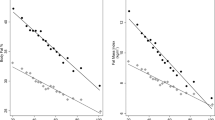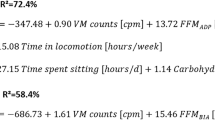Abstract
Background:
Activity-related energy expenditure is the most variable component of total energy expenditure and thus an important determinant of energy balance.
Objective:
To determine whether body composition is related to physical activity in both men and women.
Design:
A total of 134 healthy participants were recruited (80 women, 54 men; aged 21±2 years; body mass index, 22.0±2.4). Physical activity was measured for a period of 2 weeks using a triaxial accelerometer for movement registration (Tracmor). Percentage body fat (%BF) was determined by underwater weighing and deuterium dilution according to Siri's three-compartment model.
Results:
The participant characteristics—body mass, height and gender together explained a substantial part of the variation in %BF (R2=0.75, SEE=4.0%). Adding physical activity to the model increased the explained variation in %BF with 4% (R2=0.79, SEE=3.7%, P<0.001). Taking seasonality into account by adding the number of daylight hours as an independent variable further increased the explained variation with 1% (R2=0.80, SEE=3.7%, P<0.05). In analogy, the association was evaluated for both genders separately. In women, %BF and physical activity were significantly associated (P<0.001). In men, %BF was only associated with physical activity when seasonality was taken into account as well (P<0.05). This probably resulted from men participating more in season bound sports, because an association was found without adjusting for seasonality when only men with a consistent year-round participation in sports were considered.
Conclusion:
Evidence was found for an association between body composition and physical activity in both genders. A consistent year-round degree of physical activity appears to be a prerequisite to reveal the association. Moreover, Tracmor-assessed physical activity improves the estimate of %BF when a participant's characteristics are taken into account.
This is a preview of subscription content, access via your institution
Access options
Subscribe to this journal
Receive 12 print issues and online access
$259.00 per year
only $21.58 per issue
Buy this article
- Purchase on Springer Link
- Instant access to full article PDF
Prices may be subject to local taxes which are calculated during checkout


Similar content being viewed by others
References
Heini AF, Weinsier RL . Divergent trends in obesity and fat intake patterns: the American paradox. Am J Med 1997; 102: 259–264.
Seidell JC . Dietary fat and obesity: an epidemiologic perspective. Am J Clin Nutr 1998; 67: 546S–550S.
Donahue RP, Abbott RD . Central obesity and coronary heart disease in men. Lancet 1987; 2: 1215.
Hubert HB, Feinleib M, McNamara PM, Castelli WP . Obesity as an independent risk factor for cardiovascular disease: a 26-year follow-up of participants in the Framingham Heart Study. Circulation 1983; 67: 968–977.
Lew EA . Mortality and weight: insured lives and the American Cancer Society studies. Ann Intern Med 1985; 103: 1024–1029.
Pi-Sunyer FX . Medical hazards of obesity. Ann Intern Med 1993; 119: 655–660.
Ravussin E, Swinburn BA . Pathophysiology of obesity. Lancet 1992; 340: 404–408.
Black AE, Coward WA, Cole TJ, Prentice AM . Human energy expenditure in affluent societies: an analysis of 574 doubly-labelled water measurements. Eur J Clin Nutr 1996; 50: 72–92.
Westerterp KR . Pattern and intensity of physical activity. Nature 2001; 410: 539.
Westerterp KR, Plasqui G . Physical activity and human energy expenditure. Curr Opin Clin Nutr Metab Care 2004; 7: 607–613.
Ekelund U, Aman J, Yngve A, Renman C, Westerterp K, Sjostrom M . Physical activity but not energy expenditure is reduced in obese adolescents: a case-control study. Am J Clin Nutr 2002; 76: 935–941.
Esparza J, Fox C, Harper IT, Bennett PH, Schulz LO, Valencia ME et al. Daily energy expenditure in Mexican and USA Pima Indians: low physical activity as a possible cause of obesity. Int J Obes Relat Metab Disord 2000; 24: 55–59.
Heitmann BL, Kaprio J, Harris JR, Rissanen A, Korkeila M, Koskenvuo M . Are genetic determinants of weight gain modified by leisure-time physical activity? A prospective study of Finnish twins. Am J Clin Nutr 1997; 66: 672–678.
Rising R, Harper IT, Fontvielle AM, Ferraro RT, Spraul M, Ravussin E . Determinants of total daily energy expenditure: variability in physical activity. Am J Clin Nutr 1994; 59: 800–804.
Wardle J, Guthrie C, Sanderson S, Birch L, Plomin R . Food and activity preferences in children of lean and obese parents. Int J Obes Relat Metab Disord 2001; 25: 971–977.
Weinsier RL, Hunter GR, Heini AF, Goran MI, Sell SM . The etiology of obesity: relative contribution of metabolic factors, diet, and physical activity. Am J Med 1998; 105: 145–150.
Paul DR, Novotny JA, Rumpler WV . Effects of the interaction of sex and food intake on the relation between energy expenditure and body composition. Am J Clin Nutr 2004; 79: 385–389.
Westerterp KR, Goran MI . Relationship between physical activity related energy expenditure and body composition: a gender difference. Int J Obes Relat Metab Disord 1997; 21: 184–188.
Donnelly JE, Hill JO, Jacobsen DJ, Potteiger J, Sullivan DK, Johnson SL et al. Effects of a 16-month randomized controlled exercise trial on body weight and composition in young, overweight men and women: the Midwest Exercise Trial. Arch Intern Med 2003; 163: 1343–1350.
Stubbs RJ, Sepp A, Hughes DA, Johnstone AM, King N, Horgan G et al. The effect of graded levels of exercise on energy intake and balance in free-living women. Int J Obes Relat Metab Disord 2002; 26: 866–869.
Westerterp KR, Wouters L, van Marken Lichtenbelt WD . The Maastricht protocol for the measurement of body composition and energy expenditure with labeled water. Obes Res 1995; 3 (Suppl 1): 49–57.
Siri WE . Body composition from fluid spaces and density: analysis of methods. 1961. Nutrition 1993; 9: 480–491; discussion 480, 492.
Plasqui G, Joosen AM, Kester AD, Goris AH, Westerterp KR . Measuring free-living energy expenditure and physical activity with triaxial accelerometry. Obes Res 2005; 13: 1363–1369.
Ainsworth BE, Haskell WL, Whitt MC, Irwin ML, Swartz AM, Strath SJ et al. Compendium of physical activities: an update of activity codes and MET intensities. Med Sci Sports Exerc 2000; 32: S498–S504.
Deurenberg P, Weststrate JA, Seidell JC . Body mass index as a measure of body fatness: age- and sex-specific prediction formulas. Br J Nutr 1991; 65: 105–114.
Wilkin TJ, Mallam KM, Metcalf BS, Jeffery AN, Voss LD . Variation in physical activity lies with the child, not his environment: evidence for an ‘activitystat’ in young children (EarlyBird 16). Int J Obes (London) 2006; 30: 1050–1055.
Westerterp KR, Meijer EP . Physical activity and parameters of aging: a physiological perspective. J Gerontol A Biol Sci Med Sci 2001; 56 (Spec No 2): 7–12.
Westerterp KR . Obesity and physical activity. Int J Obes Relat Metab Disord 1999; 23 (Suppl 1): 59–64.
Plasqui G, Westerterp KR . Seasonal variation in total energy expenditure and physical activity in Dutch young adults. Obes Res 2004; 12: 688–694.
Acknowledgements
We thank Loek Wouters for analyzing the deuterium samples.
Author information
Authors and Affiliations
Corresponding author
Rights and permissions
About this article
Cite this article
den Hoed, M., Westerterp, K. Body composition is associated with physical activity in daily life as measured using a triaxial accelerometer in both men and women. Int J Obes 32, 1264–1270 (2008). https://doi.org/10.1038/ijo.2008.72
Received:
Revised:
Accepted:
Published:
Issue Date:
DOI: https://doi.org/10.1038/ijo.2008.72
Keywords
This article is cited by
-
Exploring the Effect of Participation in Sports on the Risk of Overweight
Applied Research in Quality of Life (2015)
-
Heritability and genetic etiology of habitual physical activity: a twin study with objective measures
Genes & Nutrition (2014)
-
Beta-3-adrenergic receptor Trp64Arg polymorphism: does it modulate the relationship between exercise and percentage of body fat in young adult Japanese males?
Environmental Health and Preventive Medicine (2013)
-
Comparison of variations between percentage of body fat, body mass index and daily physical activity among young Japanese and Thai female students
Journal of Physiological Anthropology (2012)
-
Seasonal variations in physical activity and implications for human health
European Journal of Applied Physiology (2009)



